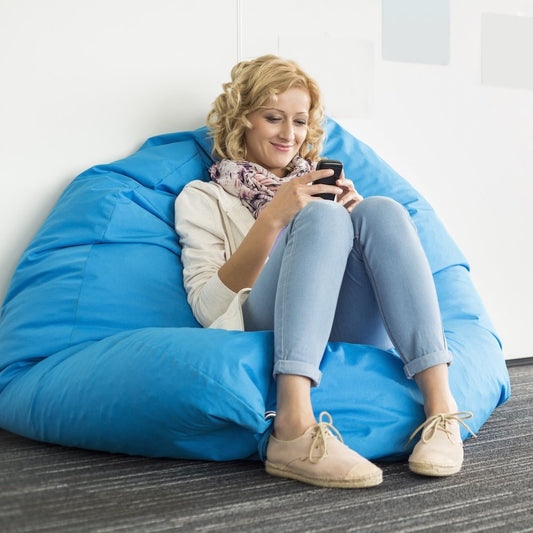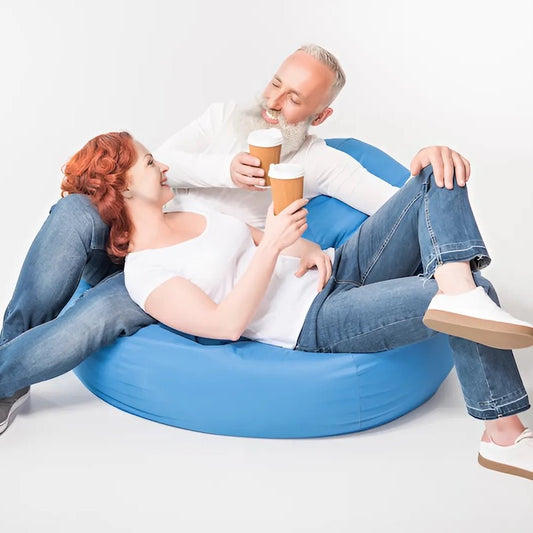Where were you in 1969? You might have been protesting a war. You might have been celebrating equal pay for women. Maybe you weren't even born. Most likely you weren't attending the Paris Furniture Fair. The bean bag chair, however, did attend the Paris Furniture Fair on January 19, 1969. Initially called the Sacco, it didn't take long before it was known as the bean bag chair. This nifty little chair was an icon of the1970s and on the Christmas list of old and young alike. But similar to mood rings and go-go boots, the popularity of the bean bag chair faded away. Or did it? The bean bag chair turns 50 soon. It's evolved over the years, but it's still going strong. Nowadays, bean bag chairs are not only found not only in family rooms. You can see them in office spaces and workplaces all over the world. If you suffer from back pain or any other type of joint pain, consider using an office beanbag in your workspace. We've prepared a list of ergonomic tips for bean bag chair users at work. Read it and prepare to relax.
A Little History of Ergonomics
Ergonomics is an ancient concept. Ancestors of modern man-probably cavemen-created tools designed to make work easier. Of course, they didn't use the word ergonomics, but they understood the concept of designing tools that fit the human body and the way it naturally moves. As civilisation advanced, inventors continued to value ergonomics. World War II and the military machines used during battle, especially aeroplane cockpits, used ergonomics as a way of organising complex controls, so that flight crews could better access and manage them. Ergonomics saved lives during the war. It helped pilots not crash planes. Fast forward to the modern office where workers are given handouts with stretching exercises printed on them. People with certain physical conditions are even offered specially designed desks and chairs. We've heard so much about it over the last several years that ergonomics isn't the workplace buzzword it was a decade or so ago. Maybe we take it for granted, but it's still relevant.Ergonomics and the Bean Bag Chair
Doctors recommend bean bag chairs for patients who suffer from back issues, and these chairs are often used to prevent other health-related problems. The filling used in bean bag chairs adapts to your sitting or lying position and adjusts to your posture. This relieves pressure on your muscles and helps with pain relief. Imagine how relaxed a person feels when they sink into the comfort of a bean bag chair after hours of sitting. People who work on computers for long hours suffer from backaches, joint aches and headaches if you think about the structure of a typical office chair you'll understand why. Most office chairs are on wheels or even worse are uncomfortable square-shaped stationary pain machines. When you sit in these chairs, you twist your body every time you reach for something. Hence, backaches. You also have little control over the distance between you and your computer screen. Bring on the headaches and eye strain. Traditional office furniture breaks most of the rules of ergonomics. Bring on the bean bags!1. Relax Your Back and Then Some
Let's look at a few ergonomic tips, which will help maximise the experience of working from your chair. People who sit in front of a computer for long stretches regularly endure neck, shoulder, and back pain. Instead of the uncomfortable chair on wheels given to most office workers, try sitting in a giant bean bag chair for at least a portion of your screen time. A large bean-bag chair provides postural support. When you support the spine, you prevent slumping of the lower back. Your spine, in turn, supports your neck, which helps avoid shoulder slouching. A straightforward remedy takes care of three problem areas.2. Add a Back Pillow
Your lower back needs appropriate support. Bean bag chairs do provide lumbar support, but you can add additional support by placing a small pillow or rolled-up towel set between your back and the back of the chair.3. Get Your Move On
No one should sit in a chair for prolonged periods. Even if your chair is a bean bag chair! At least every 10 minutes, take a short (10-20 second) break. Hands off the keys! Every 30-60 minutes, take a brief (2-5 minute) break. Get up and stretch. Take a walk around the building and get your blood pumping. Movement improves circulation, which markedly slows down when you're sitting or long periods. Movement is also the best self-remedy for creaking knees. It lubricates joints and prevents stiffness. If you're brave or don't care what others think, do a few stretches or march in place. Yes, right there in your workspace!4. Roll Your Eyes
Working at a computer puts a strain on your eyes, especially if you look at the screen for more than 20 minutes. You can avoid eye strain while working from your bean bag chair by rolling your eyes. Try these simple exercises:- Roll your eyes clockwise then counterclockwise. Don't overdo it on the eye rolls-a few times in each direction is excellent.
- Cup hands lightly over eyes for 30 seconds giving your eyes a break from irritating light-from your computer screen and the fluorescent lighting found in so many offices. t
- Look away from your computer and focus on objects on the floor or the wall. You can also focus on co-workers. They'll wonder what you're thinking.
5. Wave Your Hands
You probably won't get carpal tunnel syndrome from working at a computer, but you could risk upper-extremity disorders associated with computer use. Try a few of these hand exercises from the comfort of your chair. Place your elbows on your desk. Using one hand bend the other back toward your forearm. Hold briefly. Relax. Repeat on the opposite side. Fan your fingers out as far apart as you can. Hold. Clench fists. Release. Wave at coworkers. We're kidding but why not be friendly?6. Curl Your Toes
After a long day of sitting do your feet look like stovepipes? Swollen feet look a bit disturbing, but you probably don't have a life-threatening disorder. However, swollen feet are a common occurrence for people who sit at a desk for hours at a time. Just like moving fingers and hands helps prevent problems with arms and shoulders, moving your feet can help prevent swollen feet and ankles. We have three ergonomic tips for prevention of lower extremity issues. One can be done with your shoes on. One works better with shoes off. The third has nothing to do with moving your feet.- Rotate your foot at the ankle. Make slow, relaxed circles. Then, loop in reverse. Switch to the opposite foot and repeat. *Unless you wear tall boots or high top hiking shoes, you can leave your shoes on for this exercise.
- For this exercise flex your toes up, then curl them under your feet. Release and repeat. Toe curls work best with your shoes off. Be kind coworkers and wear clean socks!
- Put your feet up! Keep an ottoman in your workspace and use it when your feet and legs need some serious relaxation.




